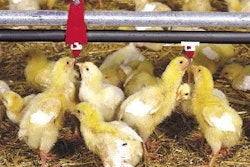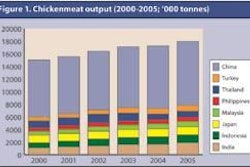HPAI (highly pathogenic avian influenza) continues to cause great concern to poultry people and those charged with public health protection in general. The H5N1 strain is responsible for culling countless millions of poultry and increasingly mammals during the latest outbreak in South Korea. Some 160 people have died mostly in Indonesia and Vietnam but also Thailand, China, Egypt and Turkey among others. Without doubt, H5N1 is an important threat to the world economy. An economic paper by Thomson Financial (a unit of Thomson Corporation) portrayed H5N1 as a bigger risk than terrorism to financial markets around the world.
H5N1 has already cost the poultry industry billions of dollars but has neither dampened the spirit of poultry farming nor seemingly the general appetite for poultry products. Of all farm animals, poultry is the most rapidly renewed livestock resource. The effect of H5N1 – if any – is to consolidate poultry farming away from smallholders and into the large integrated poultry companies to control biosecurity. Thailand is prime example of where this is happening: some poultry suppliers have clearly lost business from the outbreak about to enter its fourth year, but those involved in cleaning, re-building and renewing devastated flocks and farms have clearly not suffered to the same degree, if at all.
One positive side-effect of the H5N1 experience is the concentration of minds on ‘bread and butter’ issues and techniques like surveillance and sampling for management and control of highly infectious livestock diseases in general. At the same time, H5N1 has fuelled an unprecedented level of research and development in leading edge technologies – including serology, genetic sequencing and vaccination – that benefit the management and control of all diseases, animal and/or human.
At the same time, virologists and epidemiologists predict viral zoonotic diseases like H5N1 HPAI pose the biggest threat to human health. Zoonoses are pathogenic diseases transferred from animals to humans. Financial markets around the world reacting to news of an H5N1 outbreak often show an overall fall in value but a rise in technology stocks.
1. Disease surveillance
Poor surveillance is the single biggest factor allowing H5N1 to spread rapidly in some countries, where endemic and virtually impossible to eradicate disease has established. Indonesia is the classic example but all eyes are now on West Africa where non-existent surveillance allowed an initial outbreak in northern Nigeria a year ago to spread quickly throughout this huge country, and then across borders into Niger, Cameroon, Burkina Faso and Cote d’Ivoire within weeks. African governments claim to have controlled the disease, and apart from a recent reported outbreak in Cote d’Ivoire (in November 2006), all appears quiet. However, some experts fear that H5N1 is already endemic in West Africa, hidden in a pool of poultry and human disease showing similar symptoms.
The lack of compensation paid to affected farmers has been a big issue in Indonesia and Nigeria and considered responsible for poultry owners not reporting suspicions of disease. Pro-active surveillance is particularly important in countries where farmers are not forthcoming.
Disease surveillance in wild bird populations has helped scientists establish the role of migratory birds in disease spread. Most blame has been pinned on a relatively small group of wildfowl called ‘dabbling ducks’, which carry infection without succumbing to the disease themselves. Some like the Northern Mallard are common ancestors for almost all breeds of domestic duck and therefore likely to be of particular risk to domesticated waterfowl. These wild ducks behave differently from wild swans: the latter carry infection but succumb quite quickly to H5N1 HPAI, making them less important in long distance disease spread.
2. Meaningful samples
There are two dimensions to sound sampling. First is the pattern of sampling, ensuring that the number and spread of samples taken and tested reflect the infection level in the population under scrutiny. The second deals with sampling mechanics: how the sample is taken from birds and treated for and during transportation and storage prior to testing so there is no viral deterioration.
During the United Kingdom’s ‘dead swan’ scare in January 2006, when a wild whooper swan found dead in Scotland tested positive for H5N1, European scientists claimed the UK government’s findings of H5N1 in wild birds as generally too low. This was ascribed to inappropriate preparation technique for samples taken from birds and undergoing transit and storage prior to testing.
3. Serology to type
There are 16 known sub-types of avian influenza differentiated by structure of surface proteins called haemagglutinin and neuraminidase. Low pathogenic (LPAI) versions of H5N1 and other sub-types occur and should not be taken lightly, because low pathogenic viruses can mutate during outbreaks and become virulent. This is precisely what happened with H7N3 LPAI in Canada in February 2004 costing farmers 19 million birds from 42 commercial units and backyard flocks.
Access to accurate and fast working serological techniques allows laboratories quickly to establish sub-type and virulence of the virus faced, facilitating a quick response if required. If highly pathogenic versions of sub-types like H5N1 are identified, immediate action is required, not only to protect the domestic industry but also to inform other countries. Japan and then Hong Kong suspended South Korean imports of poultry literally within hours of confirmation of the November 2006 outbreak.
A long period before confirmation allows the disease time to spread out of control, and lack of information breeds insecurity worse for poultry markets in the long run. In addition, extensive quarantine and culling operations are expensive and may not be required for some low pathogenic sub-types endemic in a country and not notifiable under international or regional agreements.
4. Genetic sequencing
Genetic sequencing has allowed scientists to detect and describe changes in RNA strands of the virus that translate into corresponding changes in the surface proteins. These, in turn, determine crucial factors like infectivity to birds and other animals including humans, transmissibility between birds, and between birds and humans. Sequencing allows scientists to show how a particular strain is spreading and the likely source of new infections, e.g. legally or illegally traded poultry or migratory birds. Gene sequencing is the basis for development of effective matching vaccines and appraisal of the current efficacies of anti-viral drugs.
Genetic sequencing allowed scientists in Asia to identify the development of the ‘Qinghai’ strain of H5N1 in western China in May 2005, and subsequently show it was this strain that sped across western Asia into Turkey, the Balkans and Egypt, and eventually to Western Europe and West Africa.
This evidence implicated migratory birds rather than poultry imports from China, working on the basis that if poultry trading (legal or illegal) was to blame, at least some of these outbreaks would have involved the original East Asian strain. Genetic sequencing provided evidence that outbreaks in Nigeria were caused by at least three separate invasions of the virus – almost certainly on wild birds coming in from Northern Europe and Egypt along the Black Sea Migration Flyway. This was contrary to the view held by the Nigerian government – unsupported by the evidence – that infection had arrived on imported poultry from Asia.
More recently, gene sequencing allowed a combined research team from Hong Kong and the United States to plot the spread of the ‘new’ Fujian-like strain out of China and into south-east Asia, where it was responsible for an outbreak in Thailand in July 2006, after the country had been free from disease for eight months. A separate, simultaneous outbreak in Thailand was traced to the original 2004 strain, probably residual in backyard flocks, precisely because scientists had access to gene sequencing technology and gene bank documentation.
5. Sharing information
Gene sequencing on its own is not enough, however. This particularly nasty zoonotic virus, already endemic in birds in Indonesia and China, has the potential to cause a worldwide human pandemic. As such, H5N1 HPAI must be viewed and managed in a global context, which can only be achieved if accredited scientists and countries have unrestricted access to gene sequences as they arise and are elucidated by affected countries and/or their agents.
This has not happened on a sufficient scale for two reasons. First, many scientists actively researching H5N1 are pure academics for whom research papers are vital for research funding and promotion. Secondly, some countries are keeping information secret in a kind of perverse preservation of intellectual property rights hoping that information can be sold for financial gain to drug companies and the like.
This is highly dangerous, short-term thinking. The consequences of failure to manage this disease are too horrific to contemplate, with predictions of financial destruction on a world scale rapidly drowning promotional prospects for academics and ability of multi-nationals to purchase information.
After much complaint about poor information sharing by China and Indonesia in particular, more gene sequences have been deposited at two gene banks. These are Genbank, a public library of virus sequences managed by the National Institutes of Health and the Los Alamos National Laboratory Influenza Sequence Database. Both are in the USA and hold information on H5N1 for access by authorised personnel working in the field.

















